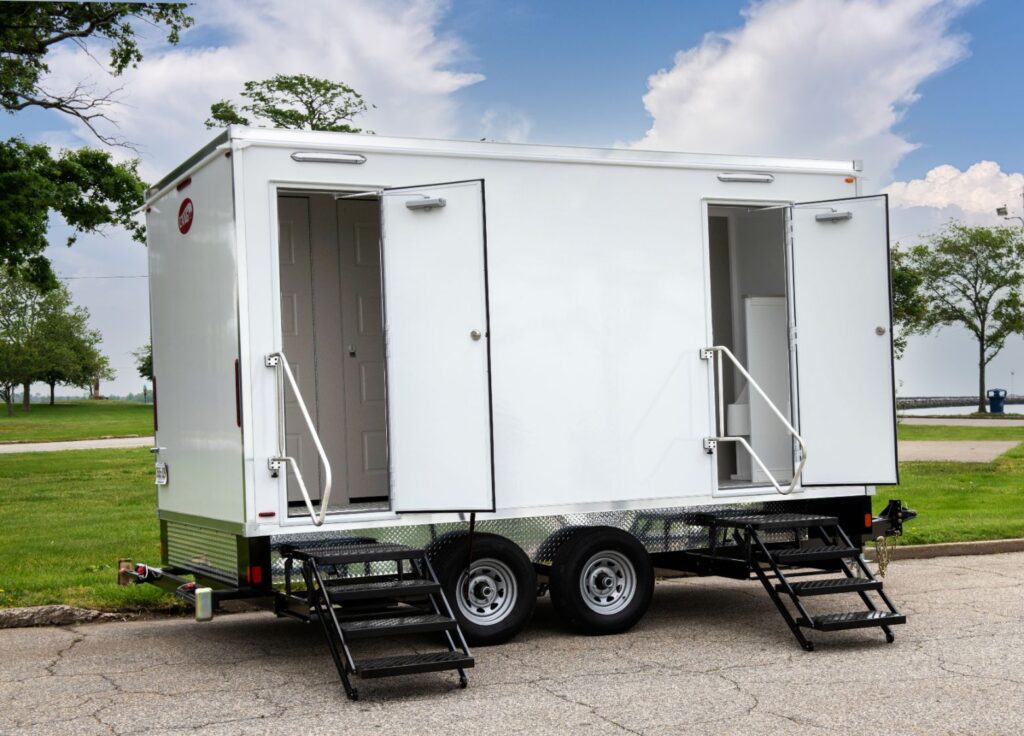Blog
Porta Potty Requirements for OSHA Compliance
Construction sites across America face stringent federal regulations governing worker sanitation facilities. The Occupational Safety and Health Administration (OSHA) enforces specific porta potty requirements that protect employee health while preventing costly violations. Understanding these compliance standards helps construction managers avoid penalties while maintaining productive, safe worksites.
OSHA Restroom Standards & Access Rules
OSHA’s sanitation standards, outlined in 29 CFR 1926.95, establish clear ratios for portable toilet provision. Construction sites must provide one toilet facility for every 20 workers or fraction thereof. A crew of 35 workers requires two units, while 41 workers necessitates three facilities.
Access requirements extend beyond mere numbers. Workers must reach toilet facilities within a reasonable walking distance—typically interpreted as 200 feet maximum from active work areas. Facilities must remain available throughout entire work shifts, not just during break periods.
Gender separation becomes mandatory when female employees comprise more than 20% of the workforce. This doesn’t necessarily require separate units; lockable facilities that ensure privacy for all workers satisfy OSHA requirements. However, many employers provide dedicated units to enhance comfort and efficiency.
Multi-story construction projects present unique challenges. OSHA requires toilet facilities on every floor where workers are actively employed, or within one floor of active work areas via stairwells or elevators. High-rise projects often utilize tower cranes to position portable units on upper levels.

Sanitation & Maintenance Requirements
Regular maintenance forms the cornerstone of OSHA compliance. Portable toilets require weekly servicing under normal conditions, though high-usage sites may need twice-weekly attention. Each service must include waste removal, tank cleaning, and chemical replenishment using EPA-approved treatments.
Hand hygiene facilities represent critical compliance elements often overlooked by contractors. OSHA mandates handwashing capabilities adjacent to toilet facilities. This requirement can be satisfied through integrated handwashing stations, standalone units, or strategically placed hand sanitizer dispensers containing at least 60% alcohol content.
Toilet paper, seat covers, and hand-drying materials must remain consistently available. Empty dispensers constitute violations that trigger immediate OSHA citations. Smart contractors implement daily inspection checklists ensuring supplies never run out during active work periods.
Waste disposal practices must follow local environmental regulations while maintaining sanitary conditions. Overflowing units create health hazards and compliance violations. Service providers should establish emergency response protocols for unexpected high-usage situations or equipment failures.
Placement & Accessibility
Strategic porta potty placement balances convenience with safety considerations. Units must sit on stable, level ground away from heavy equipment traffic patterns. Adequate lighting for early morning and evening shifts enhances both safety and compliance.
Americans with Disabilities Act (ADA) compliance requires at least one accessible unit per site, regardless of workforce size. These units feature wider doors, interior grab bars, and spacious layouts accommodating wheelchairs and mobility devices. The accessible route to these facilities must remain clear of construction materials and debris.
Food preparation and eating areas require careful consideration. OSHA prohibits toilet facilities within 200 feet of food storage, preparation, or consumption areas. This separation prevents cross-contamination while maintaining sanitary working conditions.
Proper ventilation becomes crucial in enclosed or semi-enclosed work areas. Natural airflow around porta potties prevents odor accumulation and maintains acceptable working conditions for nearby employees.
Penalties for Non-Compliance
OSHA violations carry significant financial consequences that escalate based on severity and repeat offenses. Sanitation standard violations typically result in serious citations ranging from $15,000 to $156,000 per occurrence. Willful violations can exceed $156,000, while repeat violations face mandatory doubling of penalties.
Beyond monetary fines, non-compliance creates cascading business problems. Worker productivity decreases when adequate facilities aren’t available, leading to extended break times and reduced efficiency. Health issues arising from poor sanitation can trigger workers’ compensation claims and potential lawsuits.
Reputation damage affects contractor bidding opportunities on future projects. General contractors increasingly scrutinize subcontractor safety records, including OSHA violations, when awarding contracts. A single sanitation violation can eliminate opportunities worth millions of dollars.
Maintaining Compliance Success
OSHA porta potty compliance requires proactive planning rather than reactive responses. Successful contractors establish relationships with reliable service providers, implement daily inspection protocols, and train supervisors to recognize potential violations before they occur. This comprehensive approach protects workers while safeguarding business interests in an increasingly regulated construction environment.
